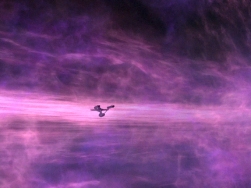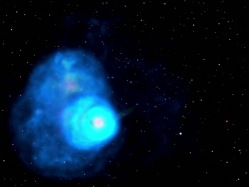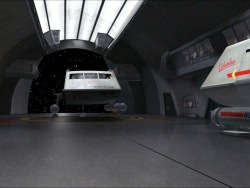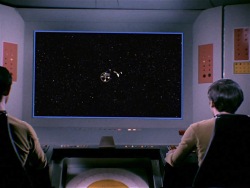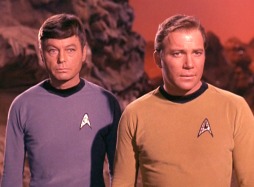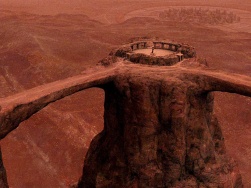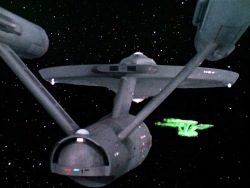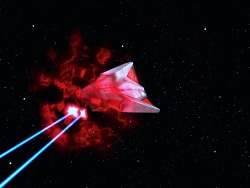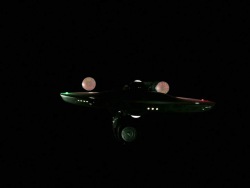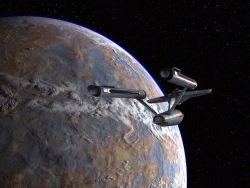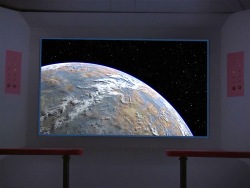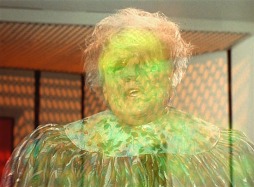17) “Where No Man Has Gone Before” Original Airdate: (9/22/66) Remaster Airdate: (1/20/07)
Evaluation:
As the pilot that sold the show, this episode contains many elements that appear to be out of place when juxtaposed with the rest of the series, i.e. different characters wearing different colored uniforms on a different bridge than the one we’re used to. The special effects here also appear inconsistent, or less refined, than those used in later shows. To whit, the CG Enterprise here was retrofitted to look like the model used in the original episode, which had antennae sticking out of the warp nacelles, a larger deflector dish and a taller bridge. The opening shot features the Enterprise slowly moving toward the camera with the Milky Way’s cloud-like arm extending laterally behind the ship…the original shot merely depicted the ship moving along in deep space. This shot earns the RM team extra credit because it honors the intentions of TOS show runners, who placed an image of our galaxy behind the ship in an unaired shot for this show. It would’ve been nice if the RM team had streamlined the original rapid zoom out, which begins by focusing on a starfield and then quickly pulling back to reveal that same patch of space on a monitor in the rec room. As is, this clunky shot looks badly dated when compared to the fluidity of contemporary camera movements. A companion visual to the opening shot is used at the top of Act I, this time at a low angle vantage (the original show filmed the ship model moving from left to right in front of a static camera). The silver and black undulations that occur when Kirk orders “screen on” haven’t been updated—this remains an odd and outmoded effect. Next up, we’re treated to our first glimpse of the pink ribbon in space known as the Galactic Barrier (hereafter GB). A thinner and sharper CG band of energy and matter has replaced the original rapidly flowing stream of pink. The effects for this episode’s many GB shots have been touched up (with wisps of blue expanding above and below the horizontal pink line), but the color, size and shape remains consistent with the original GB. The finest shot of the GB is when the Enterprise penetrates the outer edge of the barrier—there’s some minor motion as the ship tires to stabilize its attitude in the near-180 degree port/ventral pass. Once inside the GB, the viewscreen images are a far sight better than in the original show, especially the amber energy pulses. Though the pyrotechnics used on the bridge’s exploding circuit panels were retained from the original episode, the visuals hold up pretty well. However, the electro-shock field (rendered in photo negative with an animated white border and sprites) that envelops Mitchell and Dehner is a pivotal effect that should’ve been updated. The shots of the Enterprise escaping the GB are finely executed, though they’re not quite as spectacular as the ingress scene. The silver-eyed appearance of Mitchell and Dehner is effectively creepy, but one wonders if CGI could’ve been employed to make these scenes more up-to-date. All of the on-screen documents viewed at Spock’s science station and on Mitchell’s monitor in sickbay were composed on a typewriter, so it goes without saying that these inserts should’ve been updated by the RM team’s resident graphics expert, Okuda. The new Delta Vega, as seen from space and on the viewscreen, is virtually the same as the original except for a sharper rendering. The biggest disappointments in this episode are: the unmodified (save for the slow-moving clouds in the sky) matte painting of the lithium cracking station, the faux landscape seen through the station’s window and the mountainous backdrop when the action goes afield (and why wasn’t morphing employed on the scene where Gary uses his powers to transform the barren landscape into a paradise?). Regrettably, the force field FX where Gary tries to escape from the station’s brig, the phaser effects when Kirk fires the Phaser Rifle and the scenes where Mitchell and Dehner zap each other with bursts of energy, were all left untouched by the RM team. When Kirk fires at the boulder that buries Mitchell, the original sound effect continued long after the weapon ceased firing. The RM team wisely added a beam to the shot where the boulder falls, but the sound still continues for a few beats after the beam stops. The shot of the ship breaking orbit is superb and the final shot is virtually a reverse of the opening shot, as the ship heads back toward its galaxy of origin. Admittedly, updating the visual effects for this episode was an enormous undertaking and the RM team, with minor exceptions, acquitted itself well.
Money Shot: The shot of the Enterprise entering “the Galactic Barrier” (add reverb for maximum effect).
Wish List: Better FX on all energy fields that envelop Mitchell and Dehner and updated mattes on Delta Vega.
Remaster Grade: A-
Screencaps:
Original Remastered



